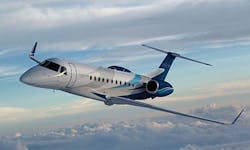Embraer chooses Ethernet-based flight recorders from Curtiss-Wright for Legacy 500 business jet flight testing
CITY OF INDUSTRY, Calif., 4 May 2012. Aircraft manufacturer Embraer S.A. in São José Dos Campos, Brazil, needed rugged data acquisition and flight data recorder technology for the Legacy 500 business jet. They found their solution from Curtiss-Wright Controls Avionics & Electronics in City of Industry, Calif.
Curtiss-Wright has completed delivery of the company's Acra KAM-500, Acra multi-role recorder, and Acra network switch subsystems to Embraer for the Legacy 500's network FAA certification program under terms of a $5 million contract. Acra Control Ltd. designed the avionics components, and Curtiss-Wright Controls acquired Acra Control in mid-2011.
The test aircraft for the Legacy 500 network FAA certification program was rolled out last December, and is preparing for flight testing this fall. Shipments of equipment sets for flight certification were finished last December.
Embraer avionics engineers are moving from traditional pulse code modulation (PCM) to Ethernet-based technology, so they chose Curtiss-Wright Controls to provide their company's first Ethernet flight certification program, Curtiss-Wright officials say. The Ethernet-based flight recorder will help provide the FAA with performance results from dual Ethernet and PCM data streams.
The move to modern data acquisition and data recorder systems will enable Embraer to record all network data and respond to engine, avionics, or other issues quickly, Curtiss-Wright officials say.
The Curtiss-Wright Controls Acra business unit is part of its Avionics & Electronics division. For more information contact Curtiss-Wright Controls Avionics & Electronics online at www.cwc-ae.com.
Follow Military & Aerospace Electronics and Avionics Intelligence news updates on Twitter

John Keller | Editor
John Keller is editor-in-chief of Military & Aerospace Electronics magazine, which provides extensive coverage and analysis of enabling electronic and optoelectronic technologies in military, space, and commercial aviation applications. A member of the Military & Aerospace Electronics staff since the magazine's founding in 1989, Mr. Keller took over as chief editor in 1995.

